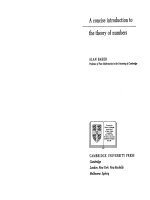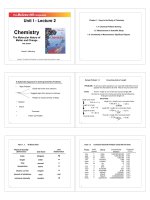A fragrant introduction to terpenoid chemistry (rsc, 2003)
Bạn đang xem bản rút gọn của tài liệu. Xem và tải ngay bản đầy đủ của tài liệu tại đây (22.16 MB, 432 trang )
A Fragrant Introduction to Terpenoid Chemistry
To Hilary,
Thank you.
A Fragrant Introduction to
Terpenoid Chemistry
Charles S Sell
Quest International, Ashford, Kent, UK
advancing t h e chemical sciences
The jacket illustration depicts a molecule of longifolene superimposed on a sprig of Pinus
longifolia. Longifolene is a major component of the leaf oil of P. longifolia and its
intriguing structure and often surprising reactions (see Chapter 7) typify the excitement
of terpenoid chemistry.
ISBN 0-85404-681-X
A catalogue record for this book is available from the British Library
0The Royal Society of Chemistry 2003
All rights reserved
Apart from any fair dealing for the purpose of research or private study, or criticism or
review as permitted under the terms of the U K Copyright, Designs and Patents Act, 1988,
this publication may not be reproduced, stored or transmitted, in anyform or by any means,
without the prior permission in writing of The Royal Society of Chemistry, or in the case of
reprographic reproduction only in accordance with the terms of the licences issued by the
Copyright Licensing Agency in the UK, or in accordance with the terms of the licences
issued by the appropriate Reproduction Rights Organization outside the UK. Enquiries
concerning reproduction outside the terms stated here should be sent to The Royal Society
of Chemistry at the address printed on this page.
Published by The Royal Society of Chemistry,
Thomas Graham House, Science Park, Milton Road,
Cambridge CB4 OWF, UK
Registered Charity Number 207890
For further information see our web site at www.rsc.org
Typeset by Alden Bookset, Northampton, UK
Printed by TJ International Ltd, Padstow, Cornwall, UK
Preface
The mind is afire to be kindled, not a vessel to be filled.
Plut arch
The book is aimed primarily at university undergraduates, postgraduates and professional chemists who wish to build up their
knowledge of terpenoid chemistry. It is intended to serve as a general
introduction to the exciting field of terpenoid chemistry. Terpenoids play
an important part in all our lives, from perfumes through insect pest
control to pharmaceuticals such as steroid hormones and the anti-cancer
drug paclitaxel. The subject therefore also serves to illustrate the
importance of chemistry in everyday life.
In the interests of length and also of the author’s expertise, we will
concentrate on the mono- and sesquiterpenoids and primarily those of
interest as fragrance ingredients. Higher terpenoids will be mentioned
and the reader will be able to extrapolate the basic principles of terpenoid
chemistry from the more detailed examples using lower terpenoids to
these higher homologues.
Chemistry is a multi-faceted discipline and each part is interconnected
with every other. It is also the central natural science, lying between
physics and biology. To understand chemistry we must understand
something of physics. Equally, since living organisms function through
chemistry, we must understand that chemistry in order to fully
understand them. I have therefore included some elements of biochemistry and molecular biology in order to illustrate the key role which
terpenoids play in the processes of life and the senses of sight and smell in
particular.
Terpenoid chemistry touches on all aspects of stereochemistry and
mechanism. However, one prominent feature of terpenoid chemistry is
that of carbocation reactions and the fundamental research which
forms the basis of our understanding of this area, was carried out on
fragrant terpenoids. Some of the most elegant of all total syntheses
involve sesquiterpenoid targets. The book will therefore also serve as a
refresher course on mechanism, stereochemistry and synthetic methodology. Where appropriate, basic principles are discussed in order to
prepare for their application to terpenoids. For example, the elements of stereochemistry are reviewed in Chapter 4 before showing how
V
vi
Preface
important they are in understanding the chemistry of carvone and
menthol. I recommend that any student readers of this book acquire a
set of molecular models. These will be particularly helpful in understanding stereochemistry and carbocation rearrangements in cyclic
molecules.
The first two chapters are designed to excite by showing the diversity
of terpenoids and their roles in living organisms. Also amazing is that
such a diversity can be produced from one simple feedstock and a
handful of chemical reactions. Students going through the book from the
beginning should not be put off by the apparently complex chemistry
described, especially in Chapter 2. The basic principles of the chemistry
are covered in detail in later chapters.
There is a selection of problems involving terpenoid chemistry and this
is followed by worked solutions. As always, problems are a good way of
testing one’s understanding of a subject and this is one of the reasons for
including a number in this book. However, some of them serve a dual
purpose and are almost integral parts of the text since they explain some
points which are, deliberately, passed over rather superficially in the
main body of the text. If the reader finds something which appears to
have been glossed over, then it would be useful to check the problems
section to see if the explanation lies there.
There is a bibliography which will serve to direct those who wish to
know more to some of the key sources of information. These are
arranged by subject in order to make it easy to use. There are also specific
references which are cited in the main body of the text. These are mostly
to original research papers and are designed to encourage the students to
test the excitement of exploring the original literature. There is a small
degree of overlap between the references and the bibliography. I felt it
better to accept this than to create a complex system of cross-referencing
which would reduce accessibility.
I believe that science and art should not be separated but should be
taken together since each helps in our understanding and appreciation of
the other. Many great scientists were also accomplished in the arts. For
example, Albert Einstein played the violin and Alexander Borodin,
besides being a professor of chemistry at a medical school in Saint
Petersburg and a leading figure in research into alkaloids, was one of the
greatest Russian composers of his day. Perfumery is clearly a blend of
creative art and chemical science. I have therefore tried to develop a link
to philosophy and the arts through the use of appropriate quotations at
the start of each chapter and by the use of perfumery as an example of
discovery chemistry.
Table of Contents
Acknowledgements
xvii
1
Chapter 1 Background
This chapter explains the definitions and classification of terpenoids. It
also describes where and why terpenoids occur in nature and how they
are extracted from natural sources.
1.1
1.2
1.3
1.4
1.5
1.6
Definitions and Classification
The Isoprene Rule
Terpenoid Nomenclature
The Role of Terpenoids in Nature
Extraction and Use of Terpenoids
Natural Inspiration
References
Chapter 2 Biosynthesis
1
3
4
6
12
17
18
19
This chapter includes a brief introduction to the processes used in
biogenesis. It explains how nature constructs the basic 5-carbon building
blocks used for terpenoid biogenesis and how these hemi-terpenoid units
are connected together to form chains of 10, 15, 20, etc. carbon atoms.
It includes a brief overview of how these chains can be cyclised and
modified to produce the staggering array of terpenoids which are present
in nature.
2.1 Introduction
2.2 Enzymes and Coenzymes
2.2.1 Adenosine Triphosphate (ATP)
2.2.2 Nicotinamide Adenine Dinucleotide
Phosphate (NADP/NADPH)
2.2.3 Coenzyme A (CoA)
2.2.4 (Co)enzymes in Summary
2.3 Biosynthesis of C5 Pyrophosphates
vii
19
20
21
22
23
24
25
...
Table of Contents
Vlll
2.4 Linear Terpenoids via Head-to-Tail Coupling
2.5 Cyclic Terpenoids Through Carbocation
Chemistry
2.6 Monoterpenoids from Geranyl Pyrophosphate
2.7 Sesquiterpenoids from Cis,Trans-Farnesyl
Pyrophosphate with Initial Closure at
the 6,7-Double Bond
2.8 Sesquiterpenoids from Cis,Trans-Farnesyl
Pyrophosphate with Initial Closure at
the 10,ll-Double Bond
2.9 Sesquiterpenoids from Trans,Trans-Farnesyl
Pyrophosphate
2.10 Diterpenoids
2.1 1 Tail-to-Tail Coupling - Triterpenoids
and Steroids
2.12 Tetraterpenoids and Carotenoids
Reference
Chapter 3 Linear and Monocyclic Monoterpenoids
28
28
34
38
39
39
40
41
42
42
43
This chapter gives a short introduction to the methods of structural
determination adopted before spectroscopy came into existence. Confirmation of proposed structures by synthesis provides an introduction
to synthetic strategy. Myrcene and citral are used as examples of these
disciplines and the chemistry of linalool and terpineol serve as a gentle
introduction to carbocation chemistry.
3.1
3.2
3.3
3.4
3.5
3.6
3.7
3.8
Structural Determination
Myrcene
Other Monoterpenes
Citral
Geraniol
Linalool
Citronellol and Citronella1
Terpineol
Chapter 4 Menthol and Carvone
44
44
48
49
54
56
60
62
65
These two key monocyclic monoterpenoids provide an excellent
illustration of isomerism: structural, geometrical and stereoisomerism.
The chapter demonstrates the importance of isomeric purity in biological
processes involving molecular recognition, the interaction of different
Table of Contents
ix
forms of isomerism and the implications of stereochemistry for
synthesis.
4.1 Types of Isomerism
4.1.1 Structural Isomerism
4.1.2 Positional Isomerism
4.1.3 Geometrical Isomerism
4.1.4 Conformational Isomerism
4.1.5 Stereoisomerism
4.2 Mint Components
4.3 Carvone
4.4 Menthol
4.5 Determination of Absolute Stereochemistry
References
Chapter 5 Bicyclic Monoterpenoids
66
66
67
67
68
71
76
78
83
93
96
97
The chemistry of pinanes, camphanes and bornanes introduces the
subject of carbocation chemistry. The basic principles governing the
reactivity of carbocations and the factors which determine the selectivity
of processes involving them, are therefore to be covered in detail in this
chapter. The dramatic changes in chemical structure which can result
from simple cation rearrangements are illustrated in these relatively easy
to visualise molecules.
5.1 Bicyclic Monoterpenoids
5.2 Two Commercial Syntheses of Bicyclic
Monoterpenoids
5.3 Chemical Puzzle Number 1
5.4 Chemical Puzzle Number 2
5.5 Chemical Puzzle Number 3
5.6 The Fundamentals of Carbocation Chemistry
5.6.1 Reaction Type 1 - Elimination
5.6.2 Reaction Type 2 - Solvolysis
5.6.3 Reaction Type 3 - H-shift
5.6.4 Reaction Type 4 - C-shift
5.6.5 Driving Force 1 - Cation Stability
5.6.6 Driving Force 2 - Ring Strain
5.6.7 Driving Force 3 - Steric Strain
5.6.8 Selectivity Factor 1 - Electron Density
5.6.9 Selectivity Factor 2 - Polarisability
97
100
102
103
104
104
104
105
106
107
111
113
114
115
116
Table of Contents
X
5.6.10 The Trans-Anti-Periplanar Rule
5.7 Explanations
5.7.1 Explanation for Chemical Puzzle Number 1
5.7.2 Explanation for Chemical Puzzle Number 2
5.7.3 Explanation for Chemical Puzzle Number 3
5.8 Previous Chemistry Revisited
5.8.1 Carvone
5.8.2 Biogenesis of the Acorane Skeleton
5.8.3 Biogenesis of the Guaiane Skeleton
5.8.4 Biogenesis of the Skeleton Caryophyllane
and Himachalane Skeleta
5.8.5 Biogenesis of the Steroid Skeleton
5.9 An Anionic Transannular Reaction
5,lO A Neutral Transannular Reaction
Chapter 6 Precious Woods
118
120
120
123
125
126
126
128
129
130
131
134
135
Sandalwood and cedarwood constituents demonstrate the increasing
complexity of carbocation reactions as the molecular size increases
from 10 to 15 carbon atoms. In addition, Cedarwood chemistry
demonstrates how changes to conditions can radically affect the outcome
of carbocation reactions. Total synthesis of sandalwood materials
introduces the Wittig reaction as a means of delivering geometric
selectivity in synthesis. At this point, a revision of the basics of carbanion
chemistry including the stereochemistry of the aldol reaction is
appropriate. Examples from the chemistry of cedrene and selinene
remind us that nothing can be taken for granted in terpenoid chemistry.
6.1 Sandalwood
6.1.1 Synthesis of a-Santalol
6.1.1.1 Stereochemistry of the Aldol
Condensation
6.1.1.2 Synthesis of 2-a-Santalol
6.1.1.3 The Wittig and Wittig-Schlosser
Reactions
6.1.2 Synthesis of P-Santalol
6.1.2.1 The Exo-effect
6.1.2.2 The Wittig Reaction with Stabilised Ylids
6.1.2.3 The Wadsworth-Emmons or
Wittig-Horner Reaction
6.1.3 Sandalwood Substitutes
6.1.4 Alkylation of a, P-Unsaturated Ketones
135
138
140
142
143
145
147
148
150
150
154
Table of Contents
xi
6.2 Cedarwood
155
6.2.1 Total Synthesis of a-Atlantone
156
6.2.1.1 Regioselectivity of Isoprene in
Friedel-Crafts and Diels-Alder chemistry 158
6.2.1.2 Synthesis of a-Atlantone from d-Limonene 159
6.2.2 Tagetones, Filifolone and Minor
Components of Atlas Cedar-wood
160
6.2.3 a-Atlantone and Deodarone
161
6.2.4 Cedrol and Cedrene
163
6.2.4.1 Friedel-Crafts Acylation of Cedrene
165
6.2.4.2 Anomalous Behaviour of Cedrene under
Friedel-Crafts Conditions
168
6.2.5 Thujopsene
170
6.2.6 Another Anomaly, Vilsmeier-Haack-Arnold
Formylation of 6-Selinene
173
References
174
Chapter 7 Other Woody Odorants
177
Vetiver, patchouli, Pinus Zongifolia, cloves and hops provide us with
examples of further increases in complexity in rearrangements, including
the santonin rearrangement, and the corresponding increase in the
challenges of total synthesis. The vetivones take us back to the use of
degradation as a tool for structural elucidation and then, through the
attendant need for total synthesis, forward to the sheer elegance of
Stork’s synthesis of p-vetivone. Longifolene shows how the course of a
reaction can be dramatically changed by the presence of a strategically
placed neighbouring atom.
7.1 Vetiver
7.1.1 Initial Structural Determination of
the Vetivones
7.1.2 The Initial Structural Determination
Disproved
7.1.3 The Correct Structure of p-Vetivone
Established
7.1.4 Bloom’s Synthesis of the Decalindienone
7.1.5 The Santonin Rearrangement
7.1.6 Marshall and Johnson’s Total Synthesis of
p-Vetivone
7.1.7 Stork’s Total Synthesis of p-Vetivone
7.1.8 Other Vetiver Components
178
178
179
183
184
186
190
193
197
xii
Table of Contents
7.2 Patchouli
198
7.3 Pine (Himalayan)
203
7.3.1 Synthesis of Longifolene
204
7.3.2 Acid Catalysed Rearrangement of Longifolene 208
7.3.3 Reactions of Isolongifolene
210
7.3.4 Reaction of Longifolene with
Bromotrichloromethane
212
7.4 Cloves and Hops
214
7.4.1 The Synthesis of Caryophyllene
215
7.4.2 Acid Catalysed Rearrangement of
Caryophyllene
220
7.4.3 Acid Catalysed Rearrangement of
Isocary ophyllene
224
7.4.4 Synthesis of Humulene
225
References
226
Chapter 8 Degradation Products
229
Nature is never static and this is demonstrated by chemical degradation
of higher terpenoids in organisms and in the environment. The emphasis
will be on the degradations which yield desirable products such as
ambergris, the ionones, darnascones, irones and theaspirones. The use of
carotenoid derived pigments in vision introduces us to receptor proteins
and the senses by which we perceive the universe around us.
8.1 Ambergris
8.1.1 Degradation of Ambreine
8.1.2 Ambergris Materials from Other Natural
Products
8.1.2.1 Clary Sage
8.1.2.2 Labdanum
8.1.2.3 Total Synthesis
8.1.2.4 Jeger’s Ketal from Manool
8.2 Carotenoids
8.2.1 Vitamin A - The Chemistry of Sight
8.2.1.1 7-Transmembrane G-coupled Receptor
Proteins
8.2.2 Violets, Roses, Orris, Osmanthus, Geranium,
Grapes, Vanilla, Raspberries, Passionfruit
and Tea - The Chemistry of Ionones and
Related Compounds
229
23 1
234
236
239
242
242
245
245
246
252
Table of Contents
8.2.2.1 Ionones
8.2.2.2 Damascones
8.2.2.3 Theaspiranes and Vitispiranes
8.2.2.4 Irones - The Chemistry of Iris
References
Chapter 9 Commercial Production of Terpenoids
...
Xlll
253
256
257
259
266
269
In this chapter, the two main reasons for organic synthesis are compared
and contrasted. In previous chapters, synthesis was a tool for structural
elucidation and the key driving force was the unambiguous nature of
the product’s structure. Similar thinking is necessary for discovery
chemistry. However, for commercial production, the key factors are
safety, cost and security. Effluent, including unwanted by-products, is
given prominence as part of the cost factor. For complex structures
related to natural products, the most cost-efficient and secure starting
materials might well be other natural products and this introduces the
issue of sustainability. The often complex interplay between all of these
parameters is illustrated through appropriate examples.
9.1
9.2
9.3
9.4
9.5
9.6
Difference Between Academic and Commercial
Syntheses
Constraints on Commercial Processes
9.2.1 Safety
9.2.2 Environment
9.2.3 Purity
9.2.4 Reproducibility
9.2.5 Capacity
9.2.6 Cost
9.2.7 Sustainability
Experimental Design
Fragrance Ingredients Derived from Terpenoids
9.4.1 Interconversion of the Five Key Terpenoids
9.4.2 Commercial Aspects
9.4.3 Evolution of Petrochemical Routes to Citral
9.4.4 Isoprene to Citral
9.4.5 Citral, Geraniol etc. from Turpentine
Product Trees
Conclusion
References
270
270
27 1
272
275
276
277
278
280
28 1
285
287
288
289
295
297
300
305
307
Table of Contents
XiV
Chapter 10 Discovery and Design of Novel Molecules
309
The basic underlying principles of discovery chemistry are the same as
those in discovery of novel molecules for all applications including
pharmaceuticals, flavour ingredients, adhesives, lubricants and so on.
The first part of the chapter outlines these basic principles and so should
serve as an introduction for any area of discovery chemistry. The second
part of the chapter uses fragrance ingredients as an example of the
discovery process.
Perfumery is a blend of science and art. The language and artistic
elements of perfumery will be discussed together with the technical
aspects of commercial perfumery. The role of structure/property
correlations (QSPRs) in the discovery of new ingredients will be covered.
This will lead on through discussion of the scope and limitations of
QSPRs to a summary of the current state of knowledge of the process
of olfaction. The contribution of discovery chemistry to the history of
perfumery is outlined and illustrated by specific examples.
10.1
10.2
10.3
10.4
10.5
10.6
10.7
Why Search for Novel Molecules?
Molecule Discovery Through Random Screening
Nature as a Source of Novel Molecules
Design Through Statistics
Design Through Understanding
Perfumery
Requirements of Fragrance Ingredients
10.7.1 Safety
10.7.1.1 Safety - In Use
10.7.1.2 Safety - In the Environment After Use
10.7.2 Odour
10.7.2.1 Odour Character
10.7.2.2 Odour Intensity
10.7.2.3 Odour Tenacity
10.7.2.4 Mechanism of Olfaction
10.7.3 Performance in Formulae
10.7.4 Performance in Product
10.7.5 Additional Benefits
10.7.6 Availability
10.8 From Natural to High Performance, Examples
of Discovery of Terpenoid Odorants
310
311
312
312
318
318
322
322
322
324
324
325
328
329
330
333
333
334
334
334
Table of Contents
10.8.1 Examples of Natural Fragrance
Ingredients
10.8.2 Examples of Analogues of Natural
Fragrance Ingredients
10.8.3 Examples of Designed Fragrance
Ingredients
10.9 Conclusion
References
xv
335
336
337
343
344
Bibliography
347
Problems
351
Solutions to Problems
369
Subject Index
395
Author Index
409
Acknowledgements
I would like to thank Professor William Motherwell and Dr Anton van
der Weerdt for their support and encouragement for this book. Without
Professor Motherwell, the work would never have been started. I am
also indebted to the late Professor Arthur Birch FAA, FRS for
introducing me to the fascinating world of terpenoid chemistry.
Professor Giovanni Appendino has also been an inspiration through
his infectious enthusiasm and love of chemistry, botany, the arts, history
and the interplay between them. In practical terms, I am indebted to
various colleagues for their comments on specific sections of the book; to
Laurence Payne for valuable input on experimental design, David
McNulty also on experimental design, Neil Vincer on safety, Paul
Hawkins on environment and Chris Furniss who bravely undertook the
task of reading the entire draft and making useful comments on the
contents. My wife Hilary deserves special thanks for her patience, good
humour, understanding, love and support, all of which helped to sustain
me through the process of writing and editing the book.
xvii
13
a
&
z
Carotene, the orange terpeniod pigment in
carrots, is used as a source of vitamin A
which is essential for sight
CHAPTER1
Background
I d 0 not know what I m a y appear to the outside world, but to myselfIseem to have
been like a boy playing on the sea-shore, and diverting myself in now and then
finding a smoother pebble or a prettier shell than ordinary, whilst the great ocean
of truth lay all undiscovered before me.
Isaac Newton
Using a simple five carbon building block, nature creates an array of
terpenoid chemicals with an infinite variety of structural variation and
vast range of biological functions. Such a cornucopia cannot but leave
the terpene chemist feeling as Newton did.
KEY POINTS
The simple isoprene unit is the basis of an enormous range and
a variety of chemical structures which we know as terpenoids.
In nature, terpenoids serve a variety of purposes including defence,
signalling and as key agents in metabolic processes.
Terpenoids have been used in perfumery, cosmetics and medicine
for thousands of years and are still extracted from natural sources
for these uses.
1.1 DEFINITIONS AND CLASSIFICATION
Plants and animals produce an amazingly diverse range of chemicals.
Most of these are based on carbon and so the chemistry of carbon came
to be known as organic chemistry, i.e. the chemistry of living organisms,
the chemistry of life. These chemical products of plants and animals can
be classified into primary and secondary metabolites. Primary metabolites
are those which are common to all species and can be sub-divided into
proteins, carbohydrates, lipids and nucleic acids. These four groups of
2
Chapter 1
materials are defined according to the chemical structures of their
members. The secondary metabolites are often referred to as “natural
products”. These can be sub-divided into terpenoids, alkaloids,
shikimates and polyketides. This classification is based on the means
by which the materials were made. These synthesis routes are referred to
as biosynthetic or biogenetic pathways.
Individual secondary metabolites may be common to a number of
species or may be produced by only one organism. Related species
often have related patterns of secondary metabolite production and so
a species can be classified according to the secondary metabolites they
produce. Such a classification is known as chemical taxonomy.
Occasionally, two plants are found to have identical physical aspects
which botanists use for classification, but differ in the secondary
metabolites they produce. For example, two flowers may look identical
but one is odourless whilst the other possesses a strong scent due to the
production of a fragrant terpenoid chemical. Such different strains are
known as chemotypes.
Terpenoids are defined as materials with molecular structures
containing carbon backbones made up of isoprene (2-methylbuta-1,3diene) units. Isoprene contains five carbon atoms and therefore, the
number of carbon atoms in any terpenoid is a multiple of five.
Degradation products of terpenoids in which carbon atoms have been
lost through chemical or biochemical processes may contain different
numbers of carbon atoms, but their overall structure will indicate their
terpenoid origin and they will still be considered as terpenoids.
The generic name “terpene” was originally applied to the
hydrocarbons found in turpentine, the suffix “ene” indicating the
presence of olefinic bonds. Each of these materials contain two
isoprene units, hence ten carbon atoms. Related materials containing
20 carbon atoms are named as diterpenes. The relationship to
isoprene was discovered later, by which time the terms monoterpene
and diterpene were well established. Hence the most basic members
of the family, i.e. those containing only one isoprene unit, came to
be known as hemiterpenoids. Table 1.1 shows various sub-divisions
of the terpenoid family based on this classification. It also shows two
specific sub-groups of terpenoid materials, namely, the carotenoids
and the steroids. Steroids and carotenoids are sub-groups of the
triterpenoids and tetraterpenoids, respectively, as will be explained
later.
Occasionally, the word terpene is used to indicate any terpenoid. In
this book, the word terpene will be restricted to its original meaning.
Similarly, the term “isoprenoid” is often used in place of “terpenoid.”
3
Background
Table 1.1 Classification of Terpenoids
Name
No. of carbon atoms
No. of isoprene units
Hemiterpenoids
1
5
Monoterpenoids
2
10
Sesquiterpenoids
3
15
Diterpenoids
4
20
Sesterterpenoids
5
25
Triterpenoids
6
30
Tetraterpenoids
8
40
Polyisoprenoids
>8
> 40
Steroids triterpenoids which produce Diels’s hydrocarbon when distilled from zinc dust
Carotenoids
8
40
1.2 THE ISOPRENE RULE
The isoprene rule, proposed by Wallach in 1887, defines terpenoids as
chemicals containing a carbon skeleton formed by the joining together
of isoprene units. Isoprene, the “building block” of terpenoids, is
2-methylbuta-1,3-diene. If we look at the parent 2-methylbutane, we
could consider the molecule to resemble a nanoscalar tadpole with a
“head” at the branched end of the molecule, the other end therefore
constituting the “tail.” Thus, in principle, two isoprene units could be
joined head-to-head, tail-to-tail or head-to-tail. By far the commonest
fusion is head-to-tail. Figure 1.1 shows two isoprene units being joined
head-to-tail to produce a monoterpenoid backbone. Occasionally, a tailto-tail coupling occurs. This is a characteristic feature of steroids and
carotenoids. In both of these classes, there is a tail-to-tail fusion exactly
in the centre of the backbone, the other joins being head-to-tail type. The
hypothetical head-to-head fusion does not occur.
After formation of the basic C5nskeleton, the chain may be folded to
produce rings and functionalised by the introduction of oxygen or other
head
tail
Figure 1.1
tail
Chapter 1
4
x
b
,&.
&OH
geraniol
'OH
>,
guaiol
OH
Figure 1.2
heteroatoms. Figure 1.2 shows how the isoprene units and the original
backbone can be traced out in three simple terpenoids. Occasionally,
skeletal rearrangements occur which make this process more difficult and
fragmentation or degradation reactions can reduce the number of carbon
atoms so that the empirical formula does not contain a simple multiple of
five carbons. Nonetheless, the natural product chemist will still quickly
recognise the characteristic terpene framework of the structure. Sometimes molecules contain both terpenoid fragments and fragments from
other biogenetic classes.
1.3 TERPENOID NOMENCLATURE
The terpenoids are divided into groups and sub-groups according to the
pathway by which nature synthesised them and hence, by their skeletal
structures since these arise directly from the biosynthesis. As described
above, the first basis for classification is the number of isoprene units
which make up the terpenoid. The names for these groups are shown in
Table 1.1. The next classification depends on whether the skeleta remain
as open chains or have been cyclised giving one, two or more rings.
Families of terpenoids possessing the same skeleton are named after a
principal member of that family, usually either the most common or
5
Background
the first to have been discovered. Charts of these names are given in
Devon and Scott’s dictionary. To name an individual terpenoid, it is
customary to use the IUPAC or CAS systems of nomenclature.
However, it is often more convenient to use either a trivial name or a
semi-systematic name derived from the terpenoid structural family to
which the material in question belongs. The trivial names often relate to
a natural source in which the terpenoid occurs.
As an example of the co-existence of systematic, semi-systematic and
trivial names, we could look at the monoterpenoid ketone, carvone.
Carvone occurs in both enantiomeric forms in nature, the Zaevo-form in
spearmint and the dextro-form in caraway. The trivial name carvone
is derived from the Latin name for caraway, Carum carvi. The basic
carbon skeleton is that of 1-isopropyl-4-methylcyclohexane. This
skeleton is very common in nature and is particularly important in
the genus Mentha, which includes various types of mint, since it forms
the backbone of most of the important components of mint oils. The
skeleton has therefore been given the name p-menthane and the numbering system used for it is shown in Figure 1.3. Therefore, any of the
following names may be used to describe the same molecule: carvone,
p-mentha- 1,8-dien-6-one and 1-methyl-4-(1-methylethenyl)cyclohex- 1ene-6-one. To classify it, we could say it was an unsaturated ketone of
the p-menthane family of monoterpenoids.
Greek letters are used in various ways to distinguish between isomeric
terpenoids. They may indicate the order in which the isomers were
discovered or their relative abundance in the oil. For instance, a-pinene
is the most significant component of turpentine, usually comprising
almost three quarters of the oil by weight. The next most significant
component is P-pinene. These structures are shown in Figure 1.4.
In the case of cyclic terpenoids, the letters a,p and y often refer to
the location of the double bond in isomeric olefins. In these cases, the
letter a indicates an endocyclic trisubstituted double bond, p refers to
2
6
5$
3
9
10
p-menthane
Figure 1.3
carvone









